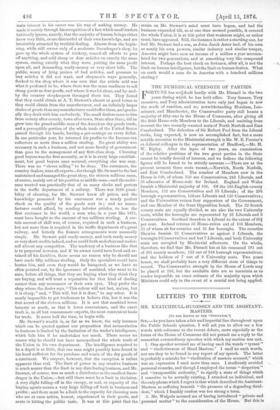THE NUMERICAL STRENGTH OF PARTIES.
FORTUNE has not dealt hardly with Mr. Disraeli in the two years during which he has held office. Tory finance, Tory measures, and Tory administration have only just begun to sow the seeds of reaction, and so, notwithstanding Horsham, Leo- minster, and Manchester„.the Conservative party still boasts a majority of fifty-one in the 'House of Commons, after giving all the Irish Home-rule Members to the Liberals, and omitting from account the two recently-vacated seats of North Norfolk and East Cumberland. The defection of Sir Robert Peel from the Liberal ranks, long expected, is now an accomplished fact, but a more notable accession to the Ministerial strength is Mr. W. E. Forster's ex-Liberal colleague in the representation of Bradford,—Mr. H. W. Ripley. After the lapse of two years, an examination of the relative positions of the two great parties in the State cannot be totally devoid of interest, and we believe the following figures will be found to be strictly accurate :—There are at the present .moment three seats vacant,—Norwich, North Norfolk, and East Cumberland. The number of Members now in the House is 649, of whom 350 are Conservatives, 243 Liberals, and 56 advocates of Home-rule for Ireland. England and Wales furnish a Ministerial majority of 106. Of the 185 English county Members, 152 are Conservatives and 33 Liberals ; of the 296 borough representatives, 156 are Liberals and 140 Conservatives ; and the Universities return four supporters of the Government, and one Member of the front opposition bench. The 32 Scotch county seats are equally divided, as are also the two University seats, whilst the boroughs are represented by 23 Liberals and 3 Conservatives. Scotland therefore is Liberal to the extent of 661 per cent. Ireland returns 56 Home-rulers out of 103 Members, 35 of whom sit for counties and 21 for boroughs. The counties likewise furnish 23 Conservatives as against 6 Liberals, the boroughs 9 Conservatives and but 7 Liberals, and both University seats are occupied by Ministerial adherents. On the whole, therefore, we find that Mr. Disraeli has at his command 191 out of 281 county members ; 152 out of 348 borough representatives; and the holders of 7 out of 9 University seats. Two years hence, we shall probably have a very different state of things to record. The Conservative strength in the House of Lords may be placed at 246, but the available data are so uncertain as to render impossible an exact estimate of the majority upon which Ministers could rely in the event of a crucial test being applied.


































 Previous page
Previous page